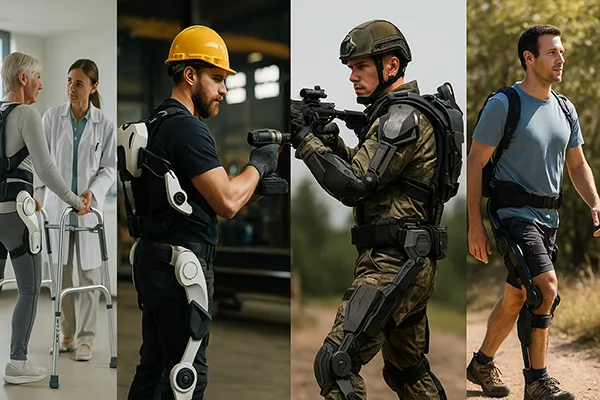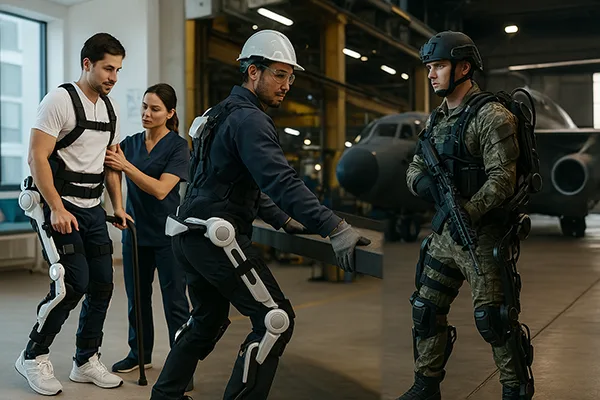In recent years, exoskeleton technologies have evolved from experimental medical aids to advanced wearable systems used across various sectors. Initially designed to assist with physical rehabilitation, these devices are now transforming industries ranging from defence to construction. As of February 2025, the line between human capability and robotic enhancement continues to blur, marking a pivotal moment in how we redefine the limits of the human body.
Medical Applications: Empowering Recovery and Independence
Medical exoskeletons were among the first to gain widespread attention, particularly in rehabilitation centres and hospitals. Devices like ReWalk and EksoNR have helped individuals with spinal cord injuries regain partial mobility and independence. These robotic suits allow patients to stand upright, walk with assistance, and engage muscles that would otherwise atrophy, offering new possibilities for long-term recovery.
In 2025, these systems are not only more accessible but also increasingly intelligent. Integration with AI-powered sensors allows for real-time adjustments based on a patient’s gait and posture. This results in more personalised therapy sessions and reduces the risk of strain or re-injury during use. Furthermore, lightweight materials and modular components make them easier to wear for extended periods.
The next frontier includes home-based rehabilitation units, enabling patients to continue therapy without being tied to a clinic. Such advancements support broader goals in healthcare: reducing costs, minimising hospital stays, and improving overall quality of life for those with mobility challenges.
Challenges in Widespread Adoption
Despite the potential, widespread adoption still faces several barriers. Cost remains a significant hurdle, as advanced exoskeletons can exceed €80,000, making them inaccessible for many without insurance or government aid. Additionally, training professionals to operate and maintain these systems is essential for ensuring safe and effective use.
Another critical factor is adaptability. No two patients present the same condition, meaning exoskeletons must be highly customisable. This requires a balance between technological sophistication and user-friendliness, which continues to be an area of development in 2025. Manufacturers are working closely with healthcare providers to refine interfaces and controls.
Lastly, regulatory approval processes differ across regions. While Europe has embraced these devices with relatively progressive policies, the pace of regulatory alignment globally affects how fast innovations can be deployed in different healthcare systems.
Industrial Exoskeletons: Enhancing Human Endurance
Outside of healthcare, exoskeletons are revolutionising physical labour in industries like manufacturing, logistics, and construction. Companies such as Hyundai Robotics and German Bionic are developing powered suits that help workers lift heavy loads, reduce fatigue, and prevent injuries caused by repetitive strain. These suits act as wearable support systems, easing pressure on the spine and joints.
By February 2025, industrial exoskeletons are becoming more integrated into daily operations. Many factories now equip workers with passive or powered suits during long shifts, especially in sectors dealing with repetitive tasks or overhead work. This not only boosts productivity but also reduces compensation claims related to workplace injuries.
Moreover, smart data tracking embedded within the exosuits enables companies to monitor ergonomic risks and worker performance. This information is invaluable for optimising workflows and identifying areas where automation or redesign may further reduce physical strain.
Balancing Human and Machine Collaboration
The goal of industrial exoskeletons is not to replace humans but to empower them. By taking over the most strenuous aspects of manual labour, these systems allow employees to focus on tasks requiring precision and judgement. In essence, it’s about combining human decision-making with robotic efficiency.
However, implementing these technologies also involves ethical and operational considerations. Companies must ensure that employees are not pressured to work longer hours simply because the exoskeleton makes it physically possible. Worker rights and health standards must evolve alongside these innovations.
Training remains essential. Exosuits require careful calibration and responsible use. Businesses that succeed in this integration typically provide onboarding programmes and ongoing assessments to make sure the tech is a benefit — not a burden — for their teams.

Military and Personal Uses: From Defence to Everyday Life
Military organisations were early adopters of exoskeletons, seeing their potential to enhance soldier endurance, speed, and strength. As of 2025, advanced suits like Lockheed Martin’s ONYX are already deployed in testing environments, assisting soldiers in carrying heavy gear over long distances and reducing muscle fatigue during missions.
Beyond combat scenarios, exoskeletons are entering civilian life. Assistive wearables for the elderly are becoming increasingly common, offering subtle mobility support without the bulk of clinical equipment. Everyday users, such as hikers or delivery workers, can now access lighter, commercially available exosuits that provide back or leg support.
Looking ahead, the fusion of exoskeletons with augmented reality (AR) and biometric feedback systems may lead to entirely new ways of experiencing movement and interaction. This could redefine everything from fitness training to remote teamwork, especially in physically demanding professions or isolated environments.
The Path to Superhuman Abilities
The concept of the “superhuman” is moving from fiction to feasible technology. While the term may sound futuristic, current progress in materials science, AI, and neuromechanics suggests that within the next decade, exoskeletons could enable feats like running faster than ever or lifting hundreds of kilograms safely.
There are, however, philosophical and social questions to consider. Should enhanced individuals be treated differently in competitive environments? Will there be restrictions in sports, workplaces, or even insurance policies? The conversation is just beginning, and regulations will need to adapt as enhancement technologies become mainstream.
Nevertheless, the trajectory is clear: exoskeletons are no longer niche innovations. They are actively reshaping how we work, heal, and move — and by 2030, they may well redefine what it means to be human.

